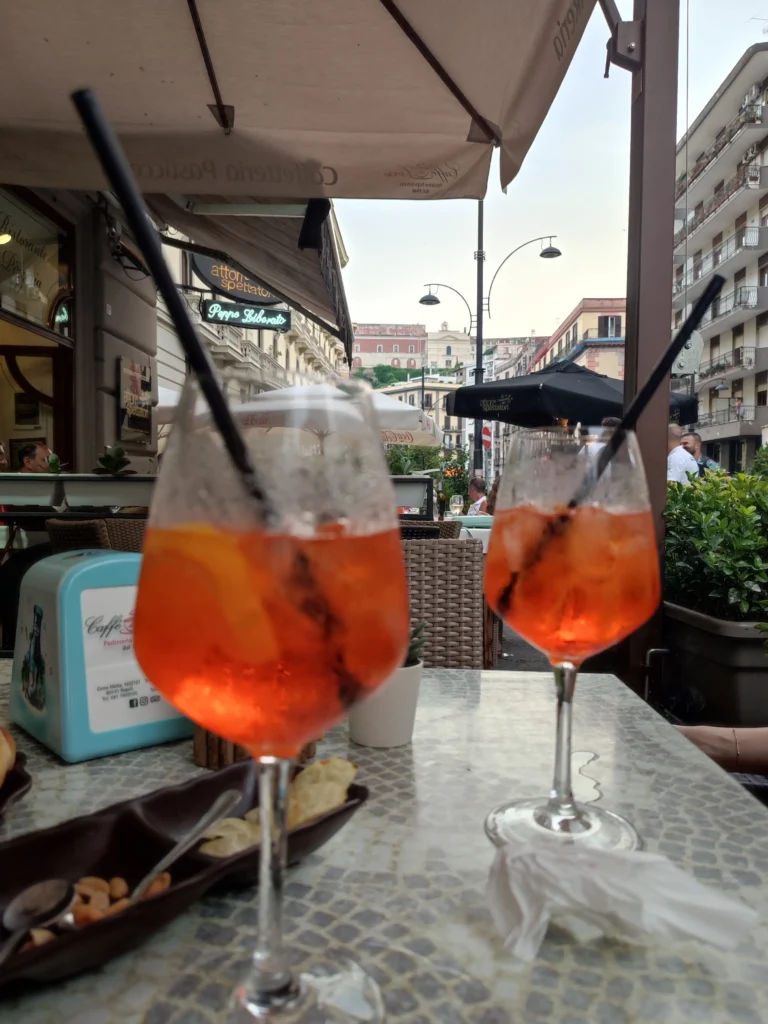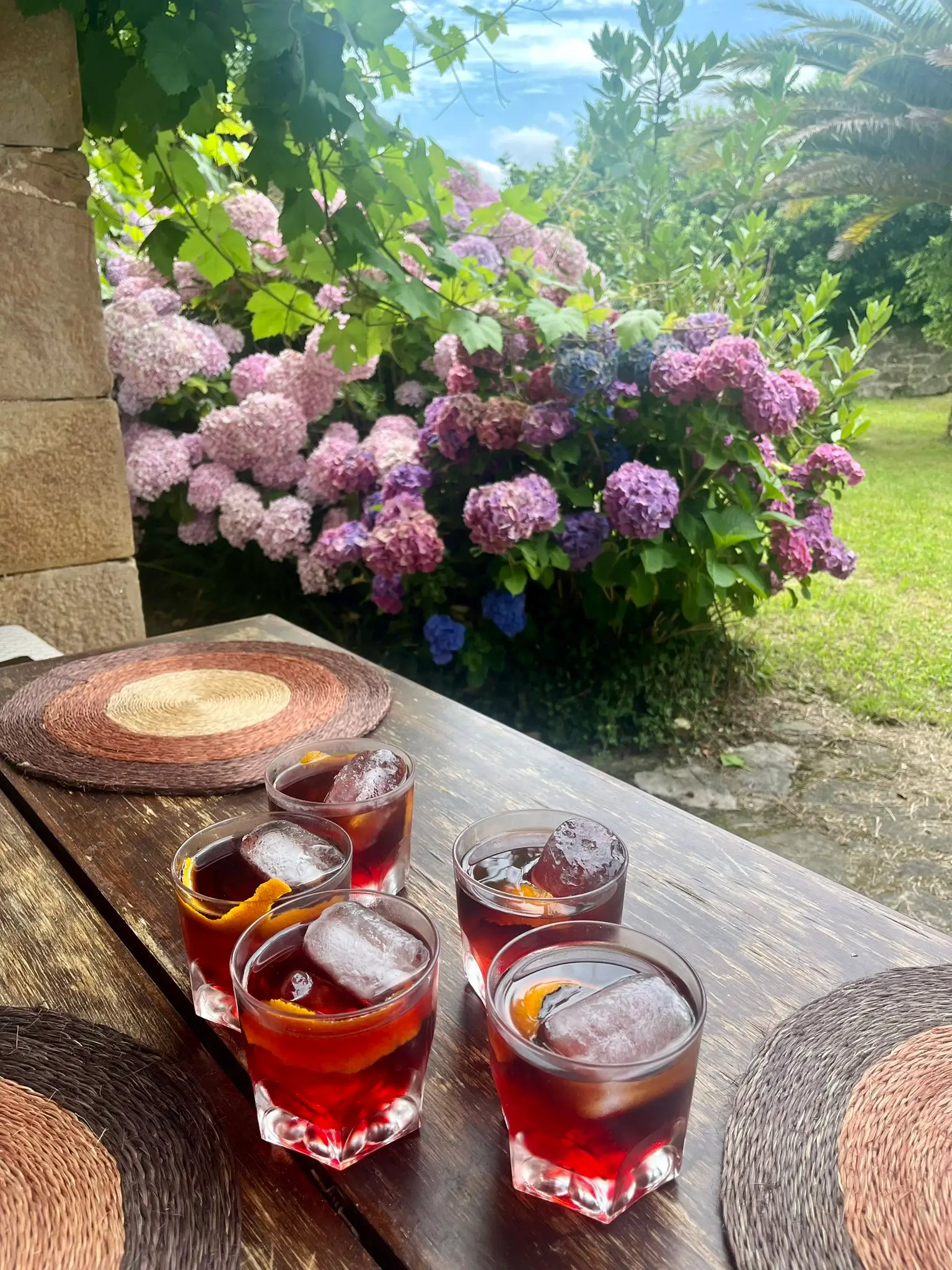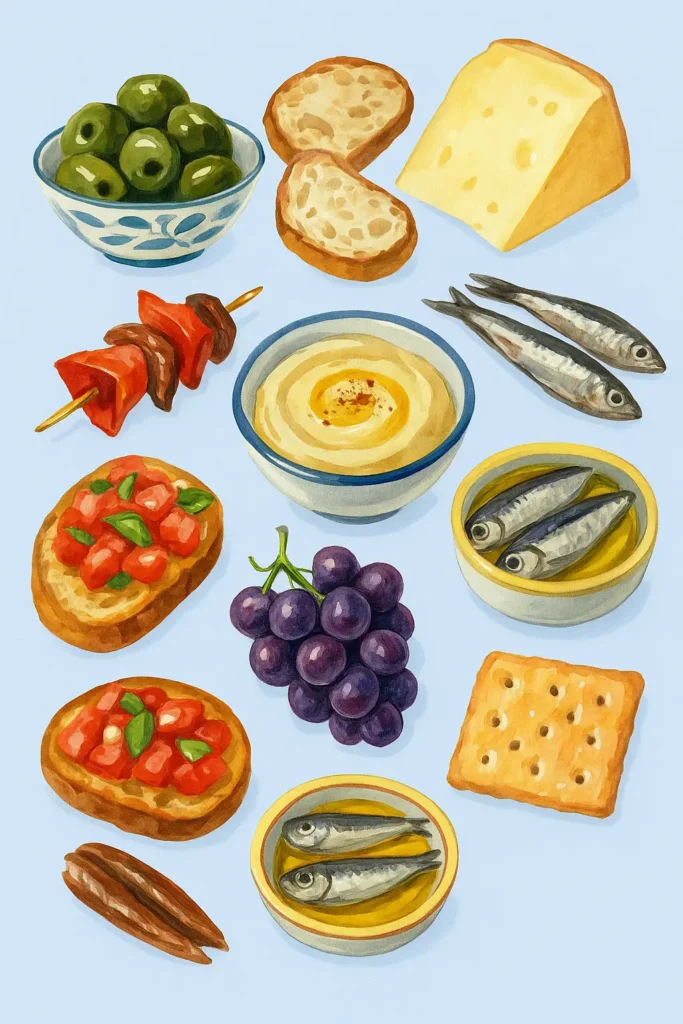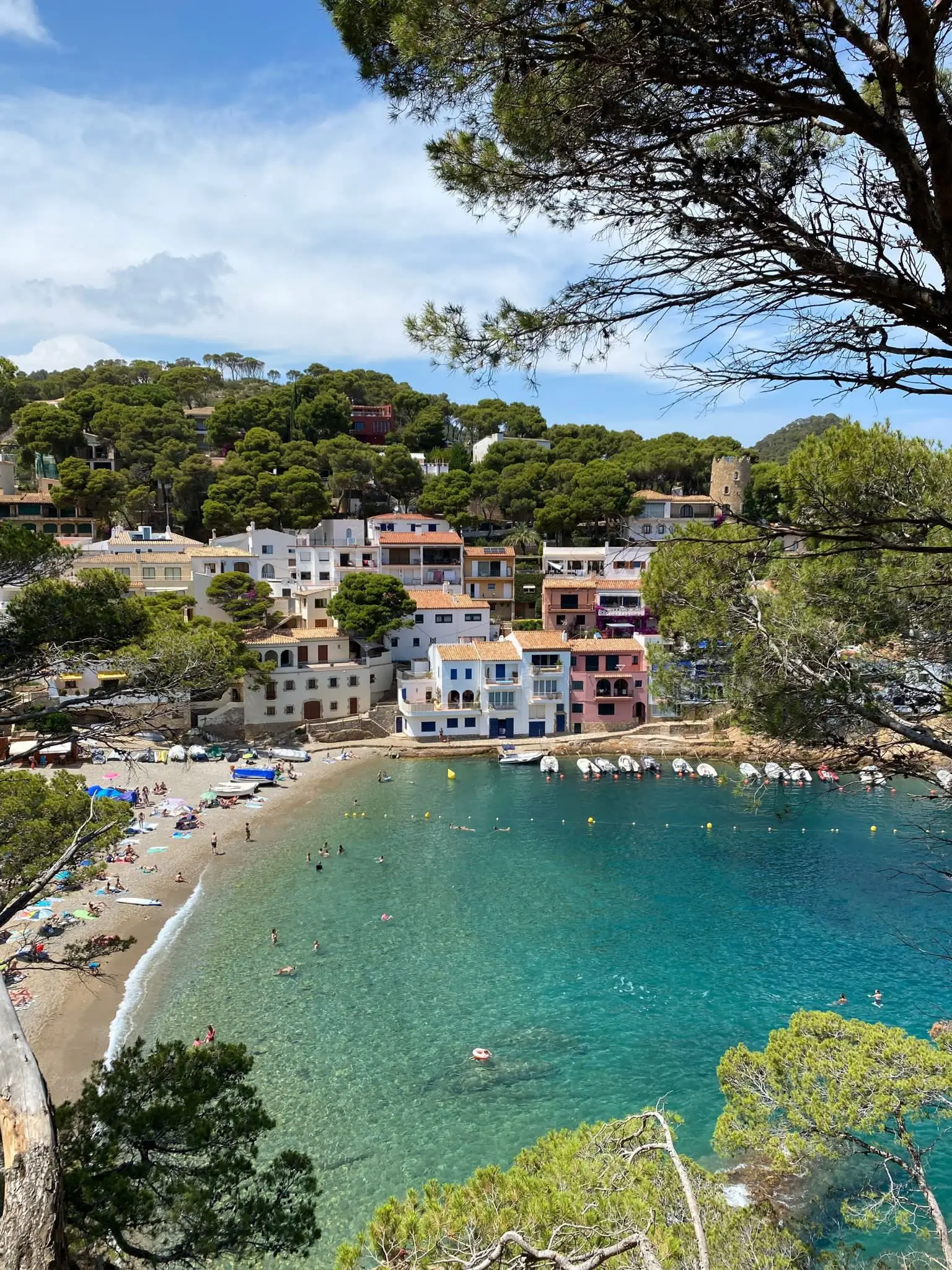The aperitivo across the Mediterranean shares more than just ingredients—it shares a spirit.
From France’s apéritif to Italy and Spain’s aperitivo, the word itself changes little. It comes from the Latin aperitīvus, meaning “that which opens,” derived from aperīre, “to open.” Originally, it referred to medicinal preparations that stimulated the appetite or aided digestion.
Today, as with most things related to food in the Mediterranean, it’s no longer just about utility. The aperitivo has become a social ritual—especially in summer—where sipping something light on a terrace with friends or family becomes a small celebration of life.
Curious to know what a true Mediterranean aperitivo looks like? What drinks are loved by Italians or Spaniards? And what kind of food usually comes with it? Let’s dive in.
Table of Contents
What Is a Mediterranean Aperitivo?
Origins of the Aperitivo Ritual
The concept of the aperitivo has ancient roots—its name, as we’ve seen, comes from Latin, but its cultural evolution unfolded across the Mediterranean. While many associate it with Italian terraces or Spanish plazas, the ritual itself stretches across borders. The French call it apéritif, the Greeks have their ouzo hour, and even in North Africa, sipping something light before a meal is a familiar practice.
So, what is an aperitivo, really?
Traditionally, it’s a drink taken before dinner, often accompanied by small bites. But in places like Italy and Spain, it has grown into something larger: a daily moment of pause, connection, and pleasure—especially during the warm months. It’s less about alcohol, and more about mood and rhythm.
In Italy, the aperitivo is typically enjoyed between 6 and 8 p.m., and it can be as simple as a glass of vermouth and a bowl of olives, or as elaborate as a buffet of small snacks in certain bars. If you’re wondering how the aperitivo works in Italy, the rule is simple: buy a drink, and the food is included. In many places, this has become a generous, informal way of dining out, especially among young people.
And what about aperitivo vs apéritif?
The difference is subtle but meaningful. The French apéritif tends to be shorter, often focused on the drink itself (like pastis, Lillet, or Champagne), whereas the Mediterranean aperitivo (especially in Italy and Spain) stretches into a social experience, often involving more food, more time, and more emphasis on company.
Typical Mediterranean Aperitivo Drinks
Across the Mediterranean, drinks served during the aperitivo hour are light, flavorful, and meant to awaken the appetite without overwhelming it. Each region has its own tradition, but what they all share is this: the drink is rarely alone. It’s always accompanied—by a snack, a view, or a friend.
If you’re hosting, you’ll want a mix of classic Mediterranean aperitif ideas, from vermouth on ice to an Aperol spritz.
Many prefer to skip alcohol altogether—try a bitter orange soda or a herbal infusion for a refreshing aperitivo drink without alcohol.

Italian Aperitifs

In Italy, Aperol spritz is the modern classic, and for good reason: it’s refreshing, easy to make, and visually striking. Its bittersweet profile, combined with Prosecco and soda, captures the relaxed glamour of Italian summer evenings.
But Italians don’t stop there. Other staples include:
- Negroni, for those who prefer something stronger and more complex (equal parts gin, sweet vermouth, and Campari).
- Vermouth di Torino, often served on the rocks with a slice of orange or olive.
- Campari soda, for a simple, bitter-forward option.
Many of these drinks are now searched globally—terms like “Aperol spritz cocktail recipe” or “Negroni cocktail recipe” have exploded in popularity. Including them in your repertoire is an easy way to recreate an authentic Italian aperitivo moment.
Spanish Aperitifs
In Spain, the aperitivo is often a pre-lunch ritual, especially on weekends. The drink that most symbolizes this hour is vermut rojo—sweet, herbal, and slightly bitter, typically served over ice with an orange slice and a green olive. It’s a timeless choice that continues to gain popularity in cities like Madrid, Zaragoza, or Barcelona.
Other popular drinks include:
- Cerveza: light, cold beer—often a small glass (caña)—is one of the most common choices.
- Vino blanco seco, especially young, crisp varieties served very cold.
- Tinto de verano, a mix of red wine and lemon soda or sparkling water, lighter than sangría and a summer staple.
- Sangría, although more associated with tourists and full meals, can occasionally appear at larger gatherings.
- Manzanilla (a type of dry sherry from Andalusia), delicate and saline, typically served chilled in southern Spain, especially with olives or fried fish.
These drinks are always accompanied by simple snacks—think olives, chips, or a slice of tortilla—and are designed for slow sipping and long conversations.

Greek and Eastern Mediterranean Options
In Greece and neighboring countries, the aperitivo concept isn’t always named as such, but the ritual is there. You’ll often find:
- Ouzo (anise-flavored and best served with water and ice),
- Tsipouro or raki (distilled spirits enjoyed slowly with meze),
- and in the Levant, arak, a similar anise liqueur often shared before big meals.
These are usually stronger than their western Mediterranean counterparts, but they come diluted, served in small quantities, and always with salty bites like cheese, olives, or roasted nuts.
Non-Alcoholic Ideas Inspired by the Med
You don’t need alcohol to enjoy an aperitivo. Some of the best options include:
- Tonic water with fresh lemon and rosemary, served cold.
- Citrus granita or crushed ice with orange and lemon juice.
- Sparkling water with a dash of pomegranate or elderflower syrup.
These alternatives are growing in popularity, especially among younger audiences, and also answer common questions like “is aperitivo healthy?”
Classic Mediterranean Bites to Pair With Your Aperitif
An aperitivo is never just about the drink—it’s the pairing that brings it to life. Whether you’re in a busy plaza in Seville or a quiet Greek island taverna, what arrives with your glass is equally important. In the Mediterranean, these bites are simple, flavorful, and designed to stimulate the appetite, not replace the meal.
The Essentials: Olives, Cheese, and Bread
Let’s start with the basics. A small bowl of green olives, ideally marinated with garlic, herbs, or citrus zest, is a constant in Spain, Italy, and Greece alike. They bring saltiness, acidity, and texture—exactly what you want before eating.

Cheese also plays a key role. Depending on where you are, you might get:
- Cubes of Manchego in Spain
- Slices of Pecorino or Parmigiano Reggiano in Italy
- Feta drizzled with olive oil in Greece
All of this is usually accompanied by bread—sliced, toasted, or rubbed with tomato. A simple pan con aceite (bread with olive oil and sea salt) can be more satisfying than any elaborate dish when paired with the right drink.
Tapas, Mezze & Antipasti: Small Bites with Big Flavor

Each country has its own tradition of pre-meal appetizers that fit naturally into the aperitivo hour:
- Spain offers classics like tortilla de patatas, boquerones (vinegar-marinated anchovies), or jamón with breadsticks.
- In Italy, you’ll find crostini with tomato or anchovy, grilled vegetables in olive oil, or artichokes from the jar.
- In Greece and the Levant, dips take center stage: tzatziki, hummus, baba ganoush, or dolmas (stuffed vine leaves) with a drizzle of lemon.
These small bites are more than just filler—they’re cultural expressions. They vary by region, by season, even by personal habit, but all share the same purpose: to awaken the palate and invite conversation.
Easy Mediterranean Aperitivo Platter (What to Serve)
Want to recreate the experience at home? Build a simple platter with:
- A mix of marinated olives and pickled vegetables
- Cured meats like salami, jamón, or prosciutto (or skip for a vegetarian version)
- 1 or 2 cheeses with contrast (a hard cheese + a soft one)
- A dip (like hummus or tapenade) with crackers or rustic bread
- Optional: seasonal fruit (grapes, figs, citrus) to balance saltiness
Keep it relaxed, not overdone. The goal isn’t to impress—it’s to enjoy.
How to Recreate the Mediterranean Aperitivo at Home
You don’t need a Mediterranean terrace or a seaside view to enjoy the magic of aperitivo hour. With just a few thoughtful touches, you can bring this everyday ritual into your home—whether you live in a city apartment or a countryside cottage. It’s about slowing down, creating atmosphere, and enjoying simple pleasures.
Setting the Scene: Lighting, Music, and Timing
Aperitivo is as much about ambience as it is about food and drink. Think golden-hour light, relaxed background music, and a sense of ease. Here’s how to set the tone:
- Lighting: If you’re outdoors, embrace natural light. Indoors, opt for warm, dimmed lamps or candles.
- Music: Create a playlist with Mediterranean jazz, bossa nova, or soft acoustic tracks from Italy, Spain, and Greece.
- Timing: Early evening is ideal—just before dinner. The ritual works best when you carve out 30–60 minutes to unwind, sip, and nibble.
You’re not hosting a dinner party; you’re inviting a pause in the day.

What to Serve Depending on the Season
The Mediterranean diet flows with the seasons, and your aperitivo platter can too. Here’s how to keep it fresh year-round:
- Summer: Serve chilled vermouth, spritzes, or tinto de verano with fresh tomatoes, soft cheese, and olives.
- Autumn: Go for amber vermouth or manzanilla with roasted peppers, nuts, and aged cheese.
- Winter: Try red vermouth or Negroni with marinated artichokes, charcuterie, and warm bread.
- Spring: Think white wine or herbal spritzes with raw veggies, dips, and young cheeses like feta or mozzarella.
A seasonal approach not only makes things tastier—it keeps the experience dynamic and local.
Final Tips to Make It Feel Authentic
The Mediterranean aperitivo isn’t about rules—it’s about rhythm. Whether you’re sipping vermouth on a quiet balcony or sharing olives and bread with friends on a weekend afternoon, the heart of the ritual is simple: slow down and savor.
You don’t need imported ingredients or a perfect setup. What you need is intention: to open your appetite, your senses, and your time to a different pace of living. That’s the essence of aperitivo.
So next time you’re winding down from the day, skip the rush. Pour something light, set out a few small bites, and enjoy the feeling that—just for a moment—you’re somewhere on the Mediterranean coast.
Aperitivo for Two vs Hosting a Summer Gathering
Whether you’re sharing the moment with a partner or planning a relaxed gathering, aperitivo adapts easily:
- For two: A single drink each, a small plate of olives and cheese, a good playlist, and the sunset.
- For a group: Offer 2–3 types of drinks (e.g. vermouth, spritz, a non-alcoholic option), a well-composed platter, and encourage grazing rather than formal serving. Let people stand, chat, and refill at their own rhythm.
In both cases, what matters is the mood—not perfection. You’re inviting people into a slice of Mediterranean life.
Frequently Asked Questions About the Mediterranean Aperitivo
What is a Mediterranean aperitivo?
It’s a pre-meal ritual common across countries like Italy, Spain, and France. It usually involves a light alcoholic drink—like vermouth, spritz, or sherry—served with small savory bites such as olives, cheese, or bread. More than a drink, it’s a cultural moment to pause, connect, and open the appetite before the evening meal.
How does the aperitivo work in Italy?
In Italy, aperitivo is typically enjoyed between 6 and 8 p.m. You order a drink (like a spritz or Negroni), and many bars include complimentary snacks—anything from chips and olives to a full buffet. It’s a social custom that blends refreshment with relaxation.
What is the difference between aperitivo and apéritif?
Both terms refer to drinks served before a meal to stimulate the appetite. Apéritif is the French version, usually short and focused on the drink (like Lillet or pastis). Aperitivo, common in Italy and Spain, is often longer, social, and accompanied by more food.
How is Spanish aperitivo different from Italian?
Spanish aperitivo is often a pre-lunch weekend ritual focused on vermut rojo, beer, or manzanilla with simple tapas. Italian aperitivo happens in the evening (6–8 p.m.) with spritzes or Negroni and can include elaborate buffets. Both prioritize socializing over drinking, but differ in timing, drinks, and accompaniments.
What is vermut rojo and how do you serve it?
Vermut rojo is Spanish sweet vermouth, traditionally served over ice with an orange slice and a green olive. It’s the classic Spanish aperitivo drink, especially popular on weekends before lunch in cities like Madrid and Barcelona.
What do Italians eat for aperitivo?
Common Italian aperitivo foods include olives, Parmigiano chunks, focaccia, crostini with tomato or anchovies, grilled vegetables, and cured meats. The goal is to keep it light and flavorful—not a full meal, but enough to open the appetite and encourage conversation.
How do you set up a Mediterranean aperitivo at home?
Choose golden hour timing, dim warm lighting, and play soft Mediterranean music. Serve 1-2 drinks (like vermouth or spritz), create a simple platter with olives, cheese, and bread, and focus on conversation over perfection. The key is slowing down, not impressing.
What are authentic non-alcoholic Mediterranean aperitivo drinks?
Try tonic water with fresh rosemary and lemon, citrus granita, or sparkling water with pomegranate syrup. These capture the refreshing, appetite-opening spirit of traditional aperitivo without alcohol.

Spanish Latte Recipe: Mediterranean Coffee Tradition Meets Modern Café Culture

Costa Brava Without the Crowds: Peaceful Towns, Coastal Trails, and Honest Local Tips

How to Start a Mediterranean Morning Ritual: Coffee, Calm, and Sea Air


